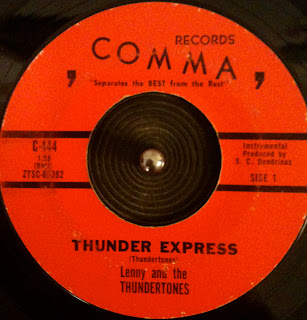 That's Glenn on the left.
That's Glenn on the left.
Glen Troutman, better known to rock’n’roll fans as Glen Glenn, might have continued playing country & western music, instead of cutting some of the greatest sides from the rockabilly era, if not for one thing: Girls!
“If you played country, girls might want your autograph,” Glenn has said. “If you did this kind of [rock’n’roll] music, girls freaked out.”
Young Troutman spent his formative years growing up in Joplin, MO, in the Missouri Ozarks, reared on the Louisiana Hayride and Opry radio, young ears tuned to the music of Roy Acuff, Red Foley, Ernest Tubb, Little Jimmy Dickens, and others. At age 14 the Troutman family, like thousands of other midwesterners [read: Okies], packed up and moved to Southern California, settling in San Dimas.
In that era, LA was a jumping musical oasis. The largely Okie enclaves of Compton and San Pedro tuned in to Town Hall Party, and the Maddox Brothers and Rose, while Central Avenue wailed with R&B by the likes of Wynonie Harris, Louis Jordan, Pee Wee Crayton and others. Too young for the clubs, Troutman soaked up the sounds of Dick "Huggy Boy" Hugg’s radio show on KRKD, and taught himself to play many of the blues and R&B songs he heard there.
Soon Glen Troutman struck up a friendship with another young guitarist named Gary Lambert. Together they formed the duo Glen & Gary and began to play talent shows and square dances at various spots around the LA basin. Sunday nights the duo hung around the old Riverside Rancho dance hall near Griffith Park at guitar legend Joe Maphis’ regular show there. During set breaks Uncle Joe hung out back, bumming their smokes, and eventually took a shine to the youngsters. Maphis suggested they take a crack at the weekly amateur show hosted by KXLA Pasadena DJ “The Squeakin’ Deacon.” This they did, taking first prize on their first attempt with their rendition of a Joe & Rose Lee Maphis number “Dim Lights, Thick Smoke.”
Despite this victory, Glen & Gary struggled to land a regular paying gig axnd recording deal. Eventually they earned a spot on The Country Barn Dance show, where, among other things, they got to be pals with the young Eddie Cochran. Recording deals remained even more elusive. Their earliest recordings were done live, in the KXLA studios, and featured versions of “That’s All Right Mama”and Glenn claims to have not yet heard Elvis’ version at that point, but rather based his rendition on what he’d heard on Huggy Boy’s radio showin 1955.
Meanwhile, as Glen & Gary kept at the hob-nobbin, rock’n’roll began to shake up the country & western world. Our two young poon-hounds had already noticed how the Town Hall Party groupies hung around seeking autographs out back behind the Riverside Rancho. But they had a revelation one night in April 1956 when they drove from San Dimas down to San Diego to catch Elvis Presley’s first west coast appearance.
“You could barely hear him,” Glenn has said. “The girls were screaming so loud.”
Due largely to these observations, Glen & Gary jumped on the R’n’R bandwagon. Their next KXLA recordings were
“Baby, Let’s Play House,” and
“Be-Bop-A-Lula.”Later in 1956, Troutman, briefly going it alone without Gary Lambert, got on the bill opening for Porter Wagoner, and began to appear on the Ozark Jubilee show. Here he made another live recording, this time it was
“Shake, Rattle, Roll.”Back in California a short time afterward, Troutman reunited with Lambert to cut versions of more rockin’ material, doing Mac Curtis’
“If I Had Me a Woman,” and Sonny Fisher’s
“Hold Me Baby.”Around this time the classic line-up of Glenn’s band began to form around Troutman on vocals, Lambert on lead guitar, and bassist Connie “Guybo” Smith on loan from old pal Eddie Cochran’s band. Fellow Missourian Wynn Stewart, likewise a California transplant who would become instrumental in the formation of Bakersfield honky-tonk, got in on the action and persuaded the band to do a string of demos. Crown jewel in this batch of recordings was their version of Stewart’s song
“One Cup of Coffee (and a Cigarette).” These demos eventually landed the boys a contract with ERA records, whose management rechristened Troutman as Glen Glenn. They promptly sent the band to the famed Gold Star studios in Hollywood, where they re-cut “One Cup of Cofee” along with
“Everybody’s Movin’”, a couple of the greatest rockabilly numbers ever committed to wax.
And what’s “One Cup of Coffee (And a Cigarette)” all about? You guessed it: Girls! Or really, it’s about the loneliness caused by one particular girl, the Everygirl, if you will. And leave it to Lonesome Wynn Stewart to nail it in a couple of quick verses:
I think I’m gonna cry if she don’t show up
Tears are gonna fall in a coffee cup
Cigarette smoke gets in my eye
That ain’t the reason that I cry
Waitin’ on my baby and she ain’t here yet
One cup of coffee (and a cigarette).
You can really see the poor sap sitting at the diner counter, alone under the harsh lights with his coffee and smokes, midnight in the middle of the big American nowhere, the heart of which, as John Rechy said in
City of Night, is loneliness.














































